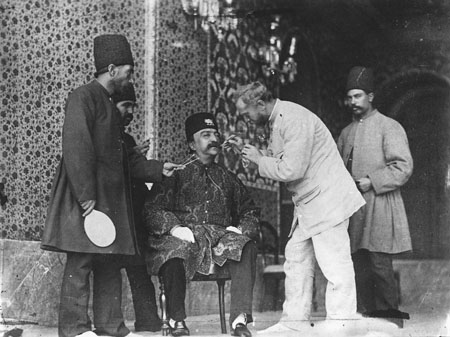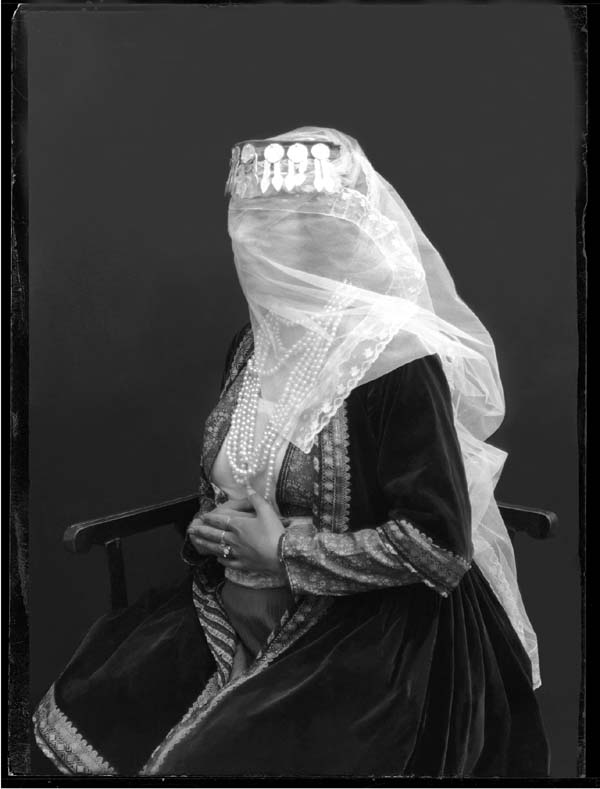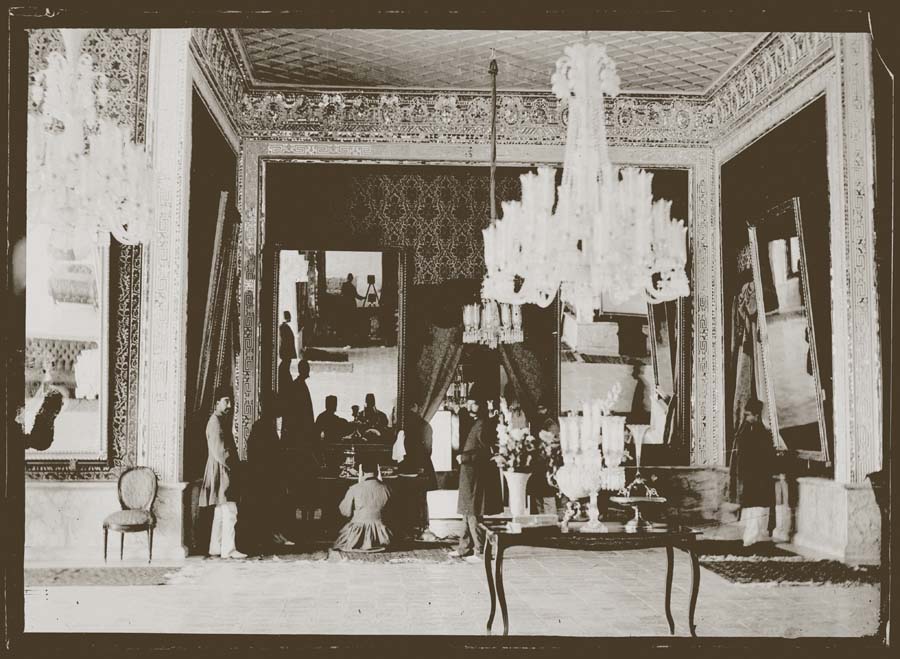
|
Williams College Museum of Art Presents Williams
College Museum of Art (WCMA) will present Antoin Sevruguin and the Persian
Image, an exhibition that offers a glimpse of turn-of-the-20th century
Iran through the eyes of one of that nation’s most creative photographers,
Antoin Sevruguin. The exhibition was organized by the Smithsonian Institution
Traveling Exhibition Service (SITES) and will be on view at WCMA from
January 10 to May 2, 2004.  Mustache, 1890, modern gelatin silver print made from original, approx. 18 x 22 inches. Antoin Sevruguin (late 1830s–1933) was a celebrated photographer of late nineteenth-century and early twentieth century Iran. He used the relatively new medium of photography to record intriguing images of Iran, its people, and their culture at a time of significant change. The exhibition shows how Sevruguin moved effortlessly back and forth between Iran and Europe, in the process creating a diverse body of photographic work that oscillates between East and West in its subject matter: veiled women, the shah, court life, western tourists, common people; and approach: portraiture, archaeological studies, and architectural street scenes.  1900, modern gelatin silver print made from original, approx. 18 x 22 inches. About the Artist Antoin Sevruguin was an Armenian Christian who lived most of his life in Tehran and traveled among the diverse worlds of Iranian society. Influenced by both Western and Eastern artistic traditions, Sevruguin brought a new sense of artistry to Iranian photography. Sevruguin’s patronage was equally diverse. He served the royal court of the shahs and he ran a portrait studio open to the public. He also journeyed to sites of Persian civilization to photograph the evocative ruins of the Iranian past, such as the ruins of Persepolis and inscriptions of the lineage and conquests of the reigns of Darius I and Xerxes I. Most of Sevruguin’s work was destroyed during his lifetime as a result of the Iranian constitutional crisis of 1906 and the civil unrest that accompanied the transition from the Qajar to the Pahlavi dynasty. Today, the Myron Bement Smith Collection of the Smithsonian’s Arthur M. Sackler Gallery and Freer Gallery of Art archives houses one of the world’s largest collections of surviving work–nearly 700 glass plate negatives–by this early photographer. The Arthur M. Sackler Gallery and adjacent Freer Gallery of Art together form the national museum of Asian art at the Smithsonian. Further information can be found at www.asia.si.edu.  1890, modern digital print made from original, approx. 22 x 27 inches Related Exhibitions and Programs To complement this exhibition, WCMA presents Forbidden Image? Persian and Mughal Painting from the Collection. The exhibition, on view from January 10 to April 25, 2004, examines a common misconception about Islamic art—that representation of the human figure is strictly forbidden. In actuality, Islamic art has a long, rich tradition of depicting people. Forbidden Image? will show that the issue of non-representation is historically a complex and disputed issue. Forbidden Image? will include 12 Persian and Mughal paintings and drawings ranging from the 15th to the 19th centuries and depicting a variety of men and beasts. These works, which represent highlights of WCMA’s Islamic holdings, also reflect Antoin Sevruguin’s study of traditional Persian painting, which influenced his photography work. Forbidden Image? Persian and Mughal Painting from the Collection was organized by Holly Edwards, Lecturer in Art at Williams College, with Stefanie Spray Jandl, Andrew W. Mellon Associate Curator for Academic Programs, in conjunction with Professor Edwards’s art history course, "Forbidden Image?" Complementing these two exhibitions is Charles Prendergast and Persian Paintings, also drawn from WCMA’s permanent collection. The five Charles Prendergast (American, 1863-1948) works on view show how Prendergast experimented with stylization, compression of space, and rich use of gold leaf and color that he so admired in Persian painting. Charles Prendergast and Persian Paintings was organized by Ellery Foutch, Curatorial Assistant, with Nancy Matthews, Eugenie Prendergast Senior Curator of 19th and 20th Century Art and Lecturer in Art. Dr. Frederick Bohrer, curator of Antoin Sevruguin and the Persian Image, will be giving a gallery talk on Thursday, April 29 at noon at Williams College Museum of Art in conjunction with Antoin Sevruguin and the Persian Image. Dr. Bohrer, Associate Professor of Art at Hood College in Frederick, Maryland, has published widely on the representation of the Near East in the 19th and early 20th centuries. He is also a contributor to, and editor of, the exhibition’s companion publication. The Williams College Museum of Art is open Tuesday through Saturday, from 10 a.m. to 5 p.m., and on Sunday from 1 to 5 p.m. Admission is free and the museum is wheelchair accessible. Contact: Suzanne Augugliaro, Public Relations Coordinator 413.597.3178; WCMA@williams.edu www.wcma.org Each year, SITES shares the wealth of Smithsonian collections and research programs with millions of people outside of Washington, D.C. One of the Smithsonian’s four National Programs, SITES makes available a wide range of exhibitions about art, science, and history. In 2002 SITES celebrated 50 years of connecting Americans to their shared cultural heritage. Exhibition descriptions and tour schedules are available at www.si.edu.sites. Williams College Museum of Art 15 Lawrence Hall Drive, Ste 2 Williamstown, MA 01267 t: 413.597.2429 f: 413.458.9017 open tu-sa 10-5, su 1-5 free admission, wheelchair accessible  Front Page Front Page |